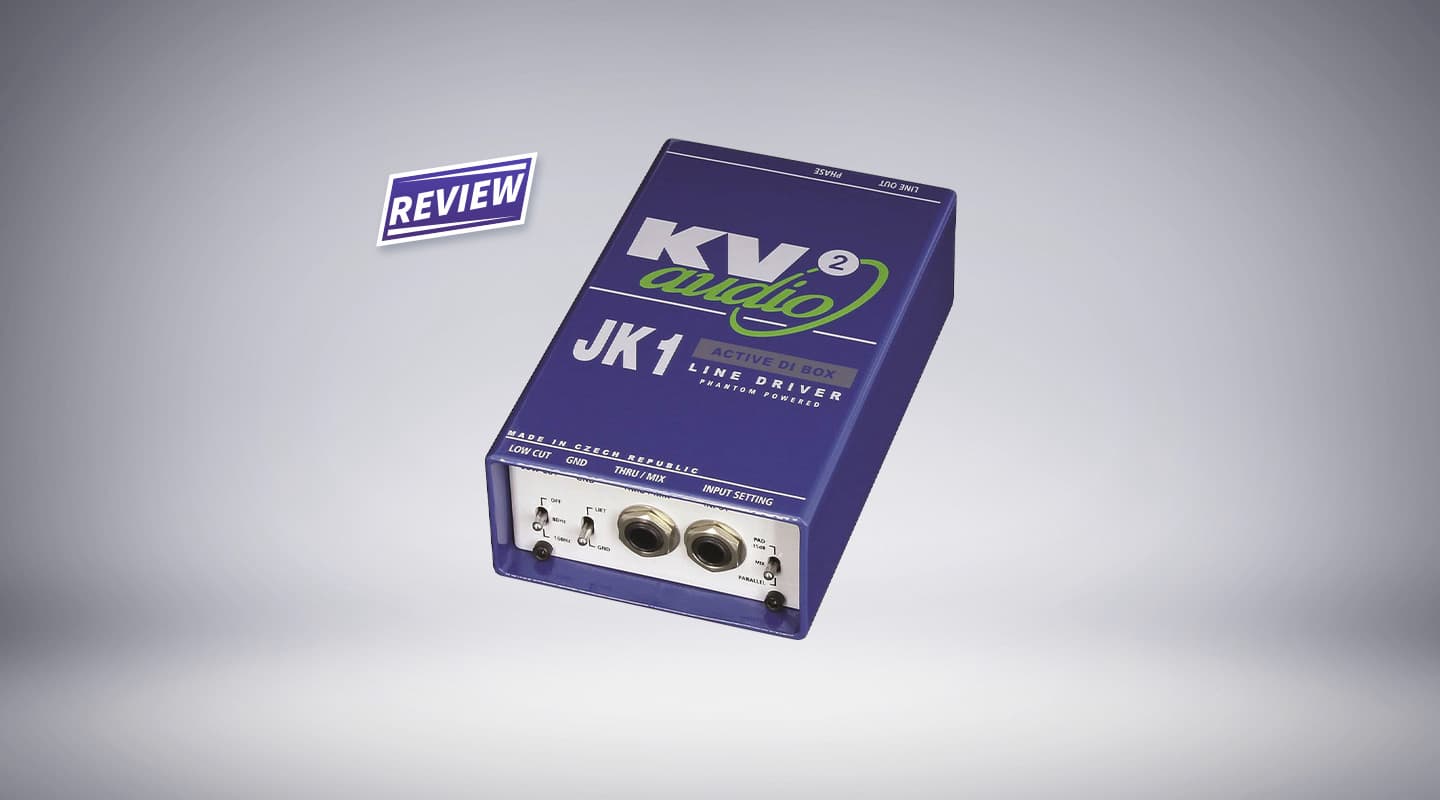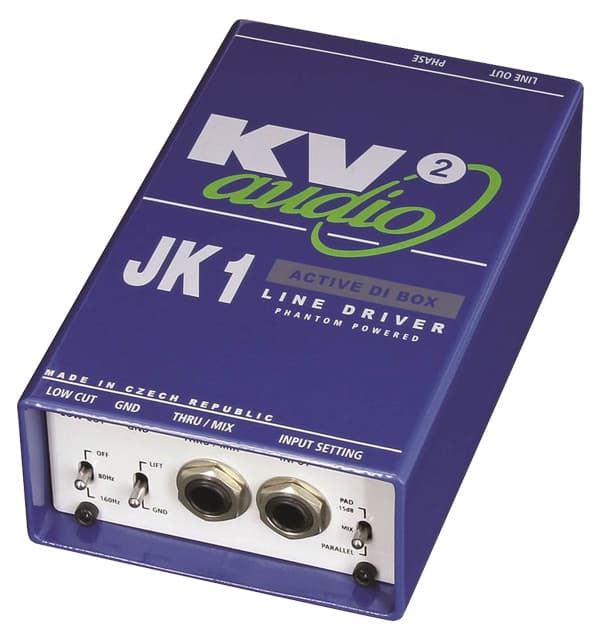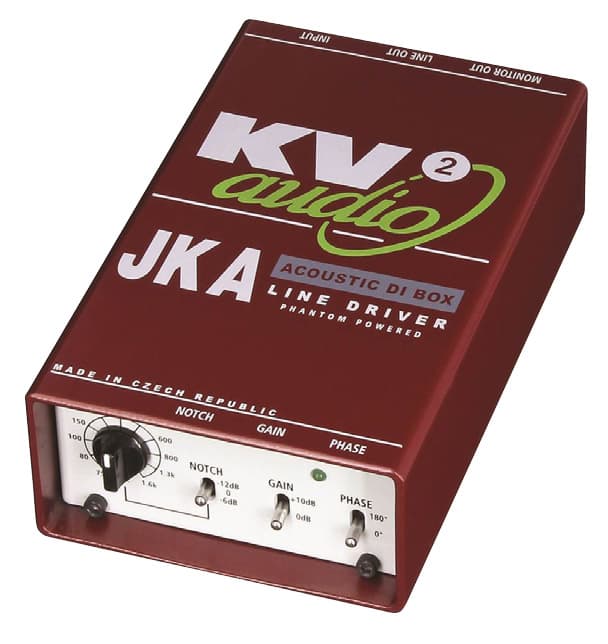
Review: KV2 Audio Line Drivers
A handful of quality-made boxes that can drive your signal all night long, all cable long, and solve a few problems along the way.
Czech-based company KV2 Audio has been around for a little over 10 years but co-founder George ‘Jiri’ Krampera has a long history of designing and building audio equipment, including time working for RCF. The company specialises in high-quality, live-audio speaker systems but is branching out into control/processing devices including the recently reviewed and extremely desirable SAC2 analogue speaker controller. This review looks at its JK (named after the founder’s initials) range of DIs and the LD4 rack-mounted four-channel line driver.
The JK Series consists of four DIs and a tone generator, all made in the Czech Republic. Build quality is very high; the cases are thick steel that provides strength, and also help with electrical shielding, while the bottom of the cases are covered in slip-proof soft rubber to stop them sliding around the stage, as well as protecting any surface they are placed on. The circuitry inside uses high-quality, low-noise components based around proprietary transformers that are hand-wound by KV2. The XLR connections are Neutrik, the switches are fully-sealed, the knobs are firm enough to resist accidental movement, yet smooth to operate. The basic functions of the JK Series are the same as other DIs; converting high-impedance, unbalanced sources to low-impedance, balanced signals to send to the mixing desk, as well as providing a ground lift and a split for connecting to an amplifier. What’s different about these DIs is the way the KV2 VHD (Very High Definition) line drivers on the outputs use phantom power and a switching power supply to provide up to 20V of peak power internally. This is used to deliver an output impedance of 50Ω, compared to around 600Ω in standard DIs. This enables long cable runs without loss of signal quality, with reduced distortion and increased dynamic range.
There are four models in the series; three active designs and one passive, and they each serve a particular purpose. For convenience, DIs should be as small as possible. The JK Series all share the same size case with dimensions of 40mm x 80mm x 131mm, which is just big enough to get all the controls and connections to fit on the end panels. They’re beautifully finished and feel solid to the touch. Each DI is colour-coded and has its model name displayed prominently on the top of the box and a brief description of its function. The quoted specs are impressive with a frequency response of -1dB between 20Hz and 100kHz, THD of better than 0.005% (slightly more for the JKA) and a greater than 130dB dynamic range.

JK1 ACTIVE DI
The JK1 is a single channel active DI with some handy extra functions. It’s in a blue box and the input end has the usual two ¼-inch jack sockets beside a three-position switch labeled Parallel, –15dB Pad, or Mix. Switched to Parallel the unit operates as a normal DI with the signal from the Input socket being sent to the Thru socket for connection to an external amplifier. The -15dB pad position is the same but the input signal is attenuated. In the Mix position the signals from both Input and Thru sockets are mixed together and sent to the output. This could be used for mixing two different sources or for combining both outputs of a keyboard or computer into one channel. Also included on the input end is a ground lift and HPF at either 80Hz or 160Hz. The output end has an XLR output socket and a phase switch that could be used to avoid phase problems with a mic and the DI, or KV2’s suggestion of correcting the phase if you meet an old ‘pin 3 hot’ mixing console. I tried the JK1 with a variety of high-impedance pickups and 100m of cable and the results were most impressive. In an A/B comparison the sound from the JK1 over the long run was unchanged compared to a 5m cable from the DI. When I swapped to a range of my usual DIs the difference was stark; dull, lifeless, reduced dynamics. I’m convinced.
NEED TO KNOW

JK2 STEREO DI
The JK2 is a two-channel active DI that I always seemed to find useful when I took it to shows. Crammed onto one end of its green case are two pairs of parallel ¼-input jack Input/Thru sockets. Each pair has a -12/-24dB pad switch and a phase switch. An interesting inclusion is a ground switch with an ‘RC’ option. When selected, the grounds of the inputs and outputs are connected, to suppress static disturbance, according to KV2. The other end of the JK2 has two output XLRs as expected… and a pair of RCA inputs… they’re at the output end because they wouldn’t fit on the input end, but it’s a handy addition. I alternated between using the JK2 as a stereo keyboard DI and for connecting computers, iPods, phones or whatever else passes as professional audio equipment these days. The unit will work with phantom power engaged on either channel but for best results KV2 recommend engaging it on both channels if both are being used.

JKP PASSIVE DI/MICROPHONE SPLITTER
The JKP is a single-channel transformer-balanced passive DI/mic splitter. Used as a normal DI it offers parallel balanced/unbalanced XLR/¼-inch jack inputs going to two XLR balanced outputs (line/monitor out), with a ground lift. But wait, there’s more. Besides the input sockets there’s a Ratio switch that toggles between 1:4 and 1:2 and changes the impedance of the source microphone. The 1:4 ratio switch decreases a condenser microphones impedance by a factor of 16 and improves the sound quality over long cable runs. The 1:2 ratio position is intended for dynamic mics or other lower impedance sources. The JKP does not require phantom power to work but to enable the use of condenser mics it will pass phantom power through the unit if the Phantom Through and Ratio 1:4 switches are engaged. The JKP can also be used as a mic splitter with the line out operating at 100Ω feeding, for example, the FOH desk and the monitor out at 600Ω going to the monitor desk.

JKA ACOUSTIC DI
I deal with lots of acoustic guitars, both live and recording, so I probably got most use from the JKA Acoustic DI. It’s got a red case and it’s been designed for high impedance sources such as pick-ups on acoustic instruments. At one end of the box there’s the familiar unbalanced ¼-inch input, an unbalanced ¼-inch link output and a balanced XLR output. The other end has the interesting stuff starting with a 10dB gain switch for boosting the signal from low-level sources. A 180-degree phase switch is also included and its uses would include providing a solution in situations where the signal from the instrument is out-of-phase with a mic on the same instrument. A notch filter completes the package; it can be switched between -12dB, -6dB, or off, and works at centre frequencies sweepable between 75Hz and 1.6kHz.
It was impressive when bluesman Eric Bibb performed at the Theatre Royal. He’s a great performer and interested in sound quality. He had two acoustic guitars that came alive when connected to the JKA. The notch filter is narrow and clean and we used it to trim some feedback-inducing resonance in the low-mids. No other EQ was required; the sound was warm, close and dynamic, with great body and none of the fizzy top end that DI’d guitars sometimes have. Performing with Swedish guitarist Staffan Astner the show was superb, standing ovation stuff, and while you can’t give a DI credit for the whole show, the JKA played its part and the artists were most appreciative.
while you can’t give a DI credit for the whole show, the JKA played its part

JKT TONE GENERATOR
The final device in the JK Series is the JKT Tone Generator. It’s not a DI/line driver at all but it’s in the same sized box and made from the same quality components. It’s run by phantom power and can generate sine wave tones from 20Hz up to 30kHz as well as white and pink noise. It’s got an output level control that drives two separate XLR outputs, one with a ¼-inch jack in parallel. The JKT can be used for trouble shooting in many audio applications. For live sound or in recording studios it can be used as a continual source to trace levels through the signal chain or to test a system’s response at various frequencies. Combined with an analyser it could be used to tune a PA and the multiple outputs mean it can check different system components at the same time. I’m often checking/chasing levels through my console-into-DAW-and-back-again setup and while I’ve got tone generators in-the-box it’s much better to use an external generator as it applies signal right from the console inputs.

VHD LD4 LINE DRIVER
Included with the JK Series of DIs, I was also sent KV2’s VHD LD4 line driver. It’s a dedicated four-channel line driver in a single rack unit case with nothing on the front panel except a power switch and the company/product logo. The rear panel has four pairs of XLR I/Os and each channel uses a ground-lifted, transformer-based power supply to produce a 50Ω output load. It’s designed for large-scale productions with long cable runs and the idea is the outputs from FOH (for instance) get connected to the LD4 using as short a cable run as possible (3m recommended). The LD4’s 50Ω output then travels to the amps on stage. It can be used with normal amplifiers but it’s been designed
to be used with KV2’s EPAK2500R and VHD2000 processor/amplifiers. These have a switchable 50Ω/10kΩ impedance switch on the inputs (the 10kΩ setting is so the amps can be used normally, without the LD4) to create an impedance-balanced connection system. This 50Ω system allows for improved performance over long cable runs by reducing reflections in the cable, lowering distortion, maintaining a flat frequency response (reduced HF roll-off) and improving dynamics (less signal compression). KV2 claim cable runs of up to 500m will not degrade the signal in any audible way.
SERIOUS STUFF
KV2 has produced a range of high-quality audio products that will mainly appeal to professional users and production supply companies. Their selling points are low output impedance, high voltage supply, superior components and excellent build quality. The LD4 line driver is a specialist product for use in large-scale productions or big venues/theatres wanting to maintain signal integrity over long cable runs. The DIs will appeal to production companies, studios or artists wanting the best available technology. The four models allow users to choose exactly which functions best suit their own situations. Serious DIs for serious users.
















RESPONSES